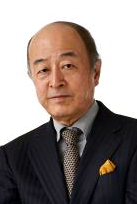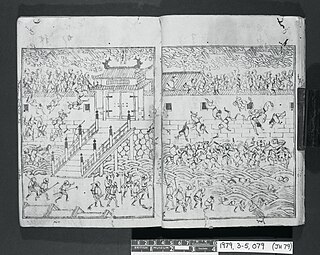| |||||
| Decades: | |||||
|---|---|---|---|---|---|
| See also: | Other events of 1683 History of Japan • Timeline • Years | ||||
Events in the year 1683 in Japan.
| |||||
| Decades: | |||||
|---|---|---|---|---|---|
| See also: | Other events of 1683 History of Japan • Timeline • Years | ||||
Events in the year 1683 in Japan.

USS Missouri (BB-63) is an Iowa-class battleship built for the United States Navy (USN) in the 1940s and is a museum ship. Completed in 1944, she is the last battleship commissioned by the United States. The ship was assigned to the Pacific Theater during World War II, where she participated in the Battles of Iwo Jima and Okinawa and shelled the Japanese home islands. Her quarterdeck was the site of the surrender of the Empire of Japan, which ended World War II.

USS Tennessee (BB-43) was the lead ship of the Tennessee class of dreadnought battleships built for the United States Navy in the 1910s. The Tennessee class was part of the standard series of twelve battleships built in the 1910s and 1920s, and were developments of the preceding New Mexico class. They were armed with a battery of twelve 14-inch (356 mm) guns in four three-gun turrets. Tennessee served in the Pacific Fleet for duration of her peacetime career. She spent the 1920s and 1930s participating in routine fleet training exercises, including the annual Fleet Problems, and cruises around the Americas and further abroad, such as a goodwill visit to Australia and New Zealand in 1925.

USS West Virginia (BB-48) was the fourth dreadnought battleship of the Colorado class, though because Washington was cancelled, she was the third and final member of the class to be completed. The Colorado class proved to be the culmination of the standard-type battleship series built for the United States Navy in the 1910s and 1920s; the ships were essentially repeats of the earlier Tennessee design, but with a significantly more powerful main battery of eight 16-inch (406 mm) guns in twin-gun turrets. West Virginia was built between her keel laying in 1920 and her commissioning into the Navy in 1923. The ship spent the 1920s and 1930s conducting routine training exercises, including the typically-annual Fleet Problems, which provided invaluable experience for the coming war in the Pacific.

USS South Dakota (BB-57) was the lead vessel of the four South Dakota-class fast battleships built for the United States Navy in the 1930s. The first American battleships designed after the Washington treaty system began to break down in the mid-1930s, the South Dakotas were able to take advantage of a treaty clause that allowed them to increase the main battery to 16-inch (406 mm) guns. However, congressional refusal to authorize larger battleships kept their displacement close to the Washington limit of 35,000 long tons (35,562 t). A requirement to be armored against the same caliber of guns as they carried, combined with the displacement restriction, resulted in cramped ships. Overcrowding was exacerbated by wartime modifications that considerably strengthened their anti-aircraft batteries and significantly increased their crews.

Yamato was the lead ship of her class of battleships built for the Imperial Japanese Navy (IJN) shortly before World War II. She and her sister ship, Musashi, were the heaviest and most powerfully armed battleships ever constructed, displacing nearly 72,000 tonnes at full load and armed with nine 46 cm (18.1 in) Type 94 main guns, which were the largest guns ever mounted on a warship.

The Great Kantō earthquake also known in Japanese as Kantō daishinsai (関東大震災) struck the Kantō Plain on the main Japanese island of Honshū at 11:58:32 JST on Saturday, September 1, 1923. Varied accounts indicate the duration of the earthquake was between four and ten minutes. Extensive firestorms and even a fire whirl added to the death toll.

Yachiyo is a city located in Chiba Prefecture, Japan. As of 31 December 2023, the city had an estimated population of 205,748 in 96,903 households and a population density of 4000 persons per km2. The total area of the city is 51.39 square kilometres (19.84 sq mi).

Hongō (本郷) is a district of Tokyo located in Bunkyō, due north of the Tokyo Imperial Palace and west of Ueno.

USS Atlanta (CL-51) of the United States Navy was the lead ship of the Atlanta class of eight light cruisers. She was the third Navy ship named after the city of Atlanta, Georgia. Designed to provide anti-aircraft protection for US naval task groups, Atlanta served in this capacity in the naval battles Midway and the Eastern Solomons. Atlanta was heavily damaged by Japanese and friendly gunfire in a night surface action on 13 November 1942 during the Naval Battle of Guadalcanal. The cruiser was sunk on her captain's orders in the afternoon of the same day.

Haruna was a warship of the Imperial Japanese Navy during World War I and World War II. Designed by the British naval engineer George Thurston, she was the fourth and last battlecruiser of the Kongō class, amongst the most heavily armed ships in any navy when built. Laid down in 1912 at the Kawasaki Shipyards in Kobe, Haruna was formally commissioned in 1915 on the same day as her sister ship, Kirishima. Haruna patrolled off the Chinese coast during World War I. During gunnery drills in 1920, an explosion destroyed one of her guns, damaged the gun turret, and killed seven men.

Tenna (天和) was a Japanese era name after Enpō and before Jōkyō. This period spanned the years from September 1681 through February 1684. The reigning emperor was Reigen-tennō (霊元天皇).

USS Monssen (DD-798) was a Fletcher-class destroyer of the United States Navy, the second Navy ship named for Lieutenant Mons Monssen (1867–1930), who was awarded the Medal of Honor for putting out a fire in a magazine on Missouri.

Bunraku Bay Puppet Troupe is an American puppet troupe that performs the traditional Japanese puppet drama commonly known as ningyō jōruri or Bunraku. Based in Columbia, Missouri, the Troupe is directed by J. Martin Holman, retired professor of Japanese language, literature, and theater at the University of Missouri, and the first non-Japanese to train and perform in the traditional puppet theater in Japan. The original puppeteers of Bunraku Bay Puppet Theater were trained in Japan by members of three traditional puppet troupes: the Tonda Puppet Troupe, founded in the 1830s in Shiga Prefecture, Japan; and the 300-year-old Kuroda Puppet Troupe and the Imada Puppet Troupe of Iida, Nagano Prefecture, Japan. In recent years most members of Bunraku Bay have spent summers training with the Imada Puppet Troupe.
Yaoya Oshichi, literally "greengrocer Oshichi", was a daughter of the greengrocer Tarobei, who lived in the Hongō neighborhood of Edo at the beginning of the Edo period. She was burned at the stake for attempting to commit arson. The story became the subject of joruri plays. The year of her birth is sometimes given as 1666.

Shin'ichirō Ikebe is a Japanese composer of contemporary classical music.
Fuyumi Sakamoto is a Japanese female enka singer under EMI Music Japan.

The fire horse(Japanese: 丙午, hinoe-uma, or へいご, heigo) or bing wu is the 43rd combination of the sexagenary cycle. According to a superstition, girls born in such a year will grow up to kill their husbands. Therefore, birthrates in Japan tend to see a sharp decline.

Fires in Edo (江戸), the former name of Tokyo, during the Edo period (1600−1868) of Japan were so frequent that the city of Edo was characterized as the saying "Fires and quarrels are the flowers of Edo" goes. Even in the modern days, the old Edo was still remembered as the "City of Fires" (火災都市).

Torii Kiyotsune was a Japanese artist of the Torii school of ukiyo-e art.
Hashira-e (柱絵) or Pillar prints are Japanese woodblock prints usually measuring about 13cm x 73cm.